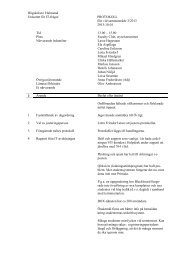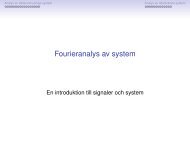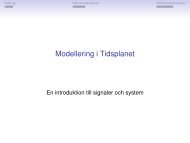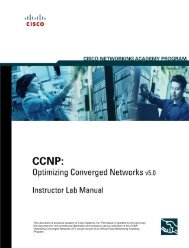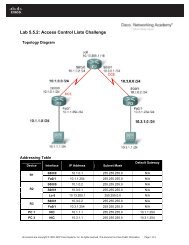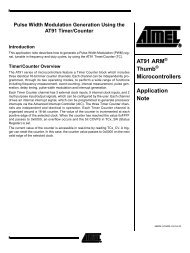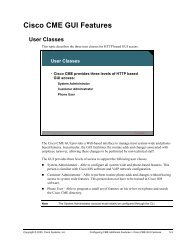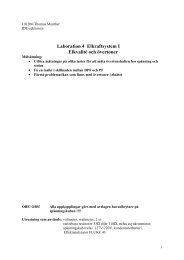ANNUAL REPORT 2012
ANNUAL REPORT 2012
ANNUAL REPORT 2012
Create successful ePaper yourself
Turn your PDF publications into a flip-book with our unique Google optimized e-Paper software.
comparatively more frequent instances where<br />
there is a negative mismatch between demands<br />
for and supply of communication resources. It is<br />
expected that resources can be allocated in a<br />
manner where some users and services, that have<br />
been identified as particularly important,<br />
experience less service disruptions in these<br />
situations.<br />
Traditional network management systems are based on<br />
a manager-agent architecture where each network element<br />
contains an agent that provides software component<br />
interfaces, which allow for remote configuration and<br />
extraction of variables. A centralized manager<br />
periodically polls the agent of a network element to get or<br />
set a value of different variables’. An agent of a network<br />
element can also asynchronously send a message to the<br />
manager, e.g. reporting the occurrence of a fault.<br />
Traditional network management systems are managed<br />
manually by a network system operator via some<br />
graphical interface. The wireless networking<br />
environments that are of primary interest in this research<br />
project, characterized by the properties described earlier,<br />
bring several added challenges to traditional, centralized<br />
network management paradigms. Such traditional<br />
network management paradigms often rely on centralized<br />
and human-controlled management decisions propagated<br />
to network elements, which are clearly not adequate as a<br />
centralized entity can never be expected to have and<br />
analyze the network state information that is necessary to<br />
make informed network management decisions. This<br />
proposed research primarily addresses two management<br />
aspects, performance management and security<br />
management, coupled to a support tool that is used during<br />
the provisioning, operation and evaluation of a cognitive<br />
network on a per-mission basis. We will here and in the<br />
following research areas use the term Cognitive Network<br />
Management System as an abstraction for this software<br />
tool.<br />
3. Goal<br />
The goal is to give an architectural description of a<br />
cognitive radio network management system in the<br />
context of network and spectrum management of next<br />
generation military tactical communication system. The<br />
main capabilities that are focused on are: simplify and<br />
shorten the mission preparation and configuration phases<br />
for national and multi-national deployments of tactical<br />
networks, improve tactical network performance by<br />
enabling dynamic spectrum and network management,<br />
and improve spectrum utility to maximize the use of<br />
military spectrum allocations. Some identified important<br />
aspects are: security aspects of cognitive network<br />
management, capabilities for local processing of goals,<br />
monitoring of the local environment, reaction to<br />
contextual events by self-configuration and information<br />
propagation for interactions with and between CNMS<br />
components and network elements, objective functions<br />
and their interrelations to measuring and control<br />
parameters. As a reference point for describing the<br />
architecture a waveform is described and analyzed from<br />
the perspective of measures, control parameters, behavior,<br />
and their relation to objective functions and mission based<br />
utility. Identification of important parameters, their<br />
behavior and relations are conducted by smaller<br />
simulation (small world isolation) and implementation<br />
studies included in the project. The approach for<br />
designing these experiments is based on requirement<br />
extraction from available scenarios and user cases. The<br />
main focus is directed towards the goal of indentifying a<br />
feasible architecture for cognitive network management<br />
system, i.e. its structural design and its behavior..<br />
4. Accomplishments<br />
The proposed system architecture is a multi-tier structure,<br />
where individual tiers can operate autonomous without<br />
overlaying tiers. These tiers reflect the horizontal structure<br />
in a network of networks. It includes everything from<br />
individual parameters of a protocol executing on a<br />
platform to higher level policy respiratory. The<br />
management interfaces, figure 1, towards the waveform is<br />
inherited from architecture derived in the ARAGORN<br />
project [3]. The low level control and learning, blue box<br />
in figure 1, is representing all algorithms that control and<br />
optimize the operation of the system in short term. It is a<br />
very big challenge to truly understand all these control<br />
parameters in waveform, how they are dependent on each<br />
other and their time constant. In order to get a better<br />
understanding of such control parameters, mechanisms,<br />
and their behavior the project especially have looked at<br />
evolutionary algorithms for resource assignment [4]-[6]<br />
(typically NP hard problems), were algorithmic stability<br />
(robustness), algorithmic convergence and time<br />
complexity especially been studied for centralized<br />
algorithms. The next step is to look at the same algorithms<br />
with decentralized implementation.<br />
Figure 1. Functional modules and interfaces.<br />
Furthermore, to understand and to be able to model the<br />
behavior of the mechanisms a theoretical benchmark<br />
CERES Annual Report <strong>2012</strong><br />
29



